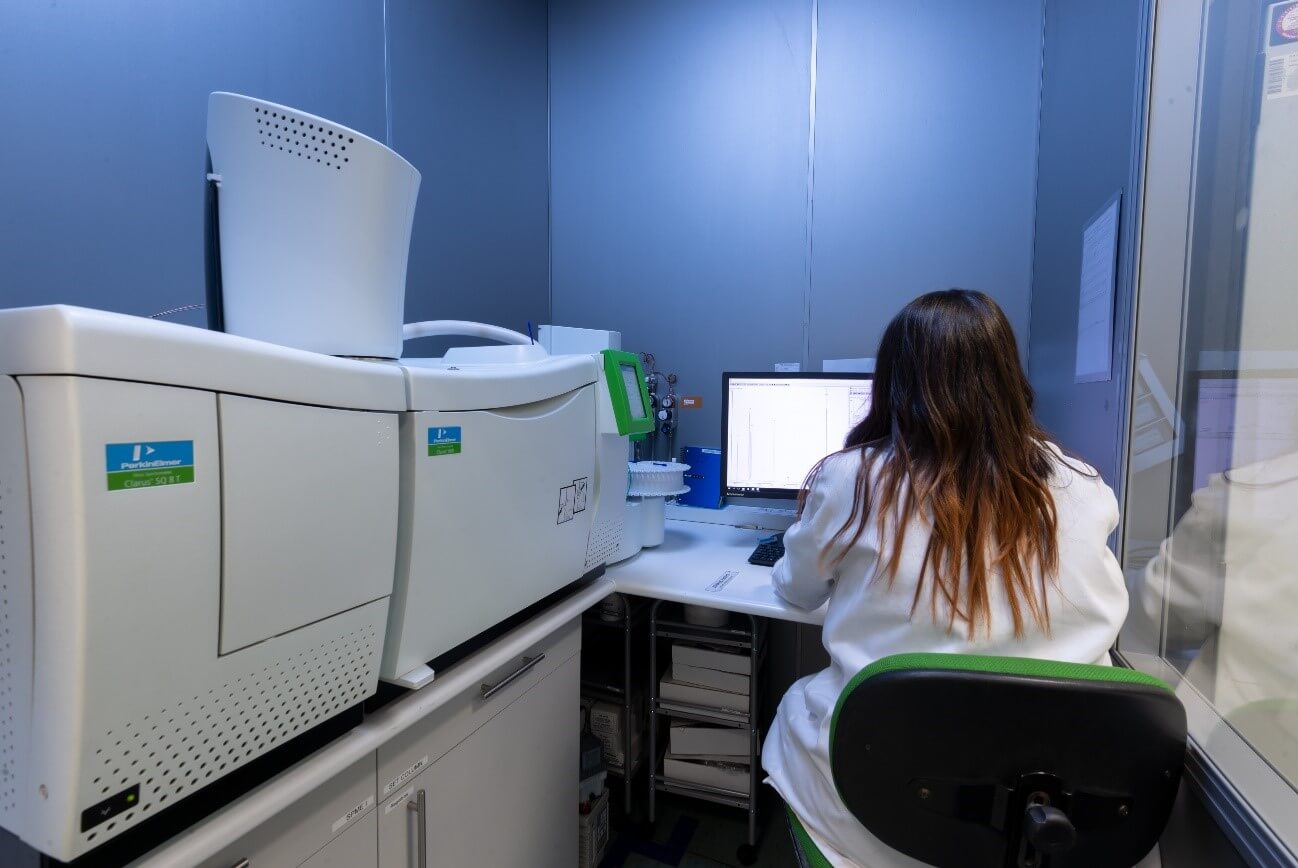Material characterization is an essential process for the control of marketed products. Among the most common techniques is gas chromatography. But what is gas chromatography? Do you know the purpose of this laboratory procedure?
In this article, we explain what gas chromatography is, what it consists of, its advantages and applications in different industries.
Gas chromatography: definition
Due to the possibilities it offers, gas chromatography or GC is one of the most widely used analytical techniques today. From the Greek “chroma” (color) and “graphia” (writing, recording), the origin of this methodology lies in the discovery and identification of colored substances such as chlorophyll.
Although liquid chromatography also exists, gas chromatography is a versatile tool used to detect compounds in a mixture from a chemical point of view by means of a gas. Silvia Pallaruelo, technical expert at Infinitia, explains: “For either type, the equipment separates the sample from a column at high temperature and directs it to a mass detector where a pattern is obtained, something like a ‘fingerprint’. This is then compared with information recorded in a database and the whole analysis is completed.
It should be noted that depending on the result we want to obtain or the sample we are going to analyze, we will choose one or the other. In this sense, gas chromatography is mainly used for potentially volatile compounds, while liquid chromatography deals with those compounds that are not easily converted to gas.
In other words: gas chromatography is a technique for separating and analyzing substances that make up a mixture. This test separates the components with the help of instruments such as the chromatographic column or the chromatograph, which we will talk about later.
Thus, at Infinitia we have two pieces of equipment in our laboratory, due to the high number of projects and analyses requested by our customers.
Applications of the gas chromatography service
So, what is gas chromatography used for? These are some of the most widespread applications:
- Environmental analysis: it is used to control environmental pollutants in water, soil and air. This is the case of pesticides, sulfur or herbicides, among others.
- Food analysis: It allows detecting, for example, the contamination of some foods.
- Industry: Gas chromatography is present in many industries. It is used to analyze gases, aromas, detect impurities, allergens, etc.
Examples of chromatography
An example of gas chromatography that we have performed in our laboratory consisted of detecting certain compounds that are formed during the cooking process in an oven. The main problems we usually encounter is that what we want to determine is not always feasible. Thus, Pallaruelo points out that “it is important to know in detail what we want to find in the process to adjust the space as much as possible”.
On the other hand, another example of this technique would be the separation of benzene and cyclohexane at their boiling points. This is very difficult to do with other methodologies, but is simplified with gas chromatography. This process is key in the production of synthetic fibers.
Gas chromatograph: what is it used for?
One of the main tools for this procedure is the gas chromatograph. Chromatographs are a machine specialized in the separation of compounds – both individually and in their families – everything will depend on their physical and chemical properties.
Therefore, this professional equipment is key in gas chromatography.
What does gas chromatographic analysis consist of?
To perform a gas chromatographic analysis, a sample must be obtained. This is introduced into the chromatograph by means of an automatic sampler or syringe, or by thermal desorption (TD). The latter is a sample preparation technique for the analysis and measurement of volatile organic compounds (VOCs) and semi-volatile organic compounds (SVOCs), based on the extraction of compounds from a sample by heating, or by direct sampling from the air.
Therefore, this type of analysis is performed by vaporizing the sample and studying how it behaves, i.e. its reactions. To do this, we use a flow of inert gas. Thus, we can find the components of the sample on the inner walls of the chromatographic column, which are released as the temperature increases. Finally, the components reach the detection chamber, where they are ionized.
Industrial sectors in which gas chromatography is used
With a wide range of applications, as we have seen in previous paragraphs, gas chromatography allows the analysis of liquids and solids in almost any field of industry. A fact that Infinitia is well aware of:
- Food industry: What is gas chromatography used for in the food industry? Very simple, it is used for those aspects related to the texture, odor or flavor of food. But chromatography is also beneficial for quality control of additives or pesticides that may interfere with the safety of the food product. “Also, within the food industry it is very useful for detecting fraud in products with high added value, such as oils and wine,” adds Javier Sanz, CEO of Infinitia. “With these products it is possible to distinguish whether the price you pay is in line with what you are offered through chromatography, making a comparison between the compounds that each oil should have,” he concludes.
- Pharmaceutical industry: Gas chromatography is used in the research, development, production and quality control of drugs. For example, it can be used to identify impurities in the compounds of these products.
- Automotive industry: It can be used to detect compounds that appear in any parts production line. Gas chromatography can also be used to analyze odors and volatile organic compounds inside a vehicle. A technique that is complemented by forensic engineering: this department uses gas chromatography when more conventional techniques do not work. “With this, the names and surnames of the molecules are revealed,” says our CEO.
- Criminalistics: Not an industry as such, but this application is worth highlighting. This laboratory technique is key in forensic medicine, since it is used to analyze the amount of alcohol or other drugs in the blood.
In Infinitia’s laboratory we are experts in analyzing volatile substances content, as well as in performing emission tests; using -among other techniques- gas chromatography. We have a full team and equipment, ideal to work with your company, contact us!

